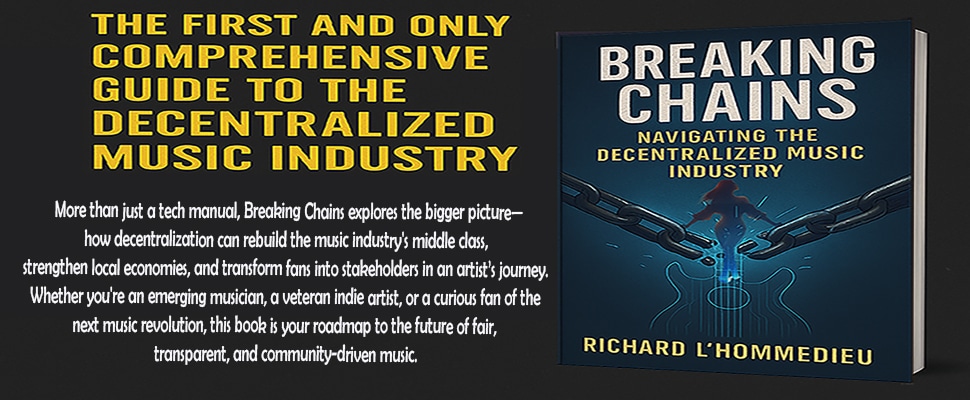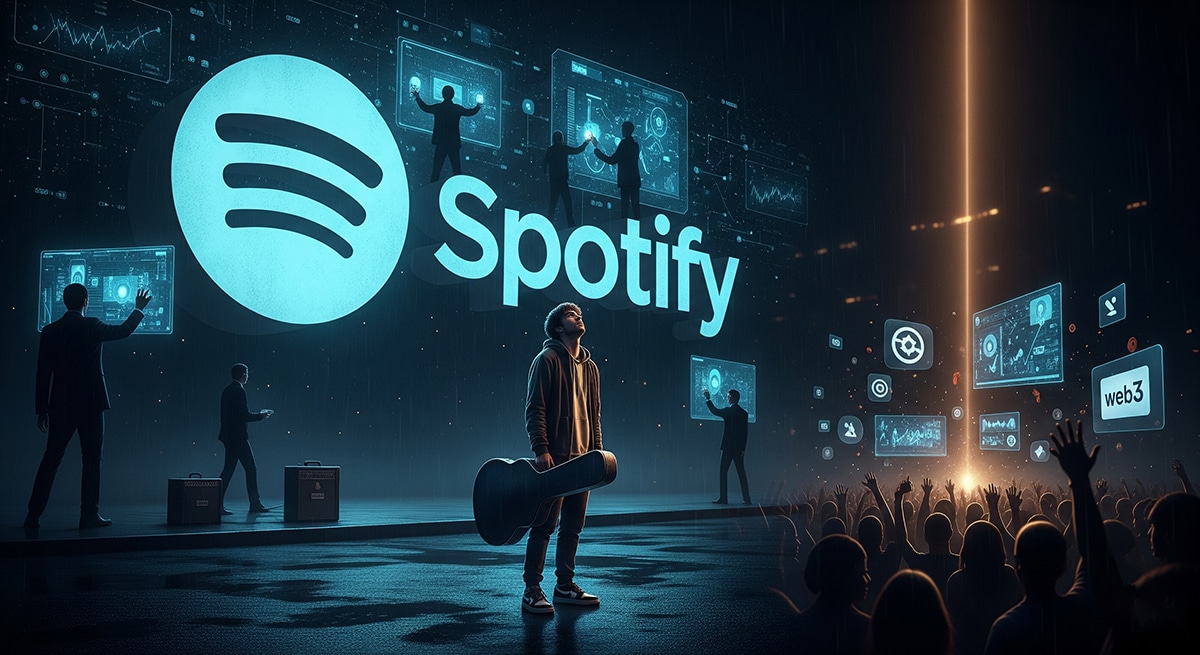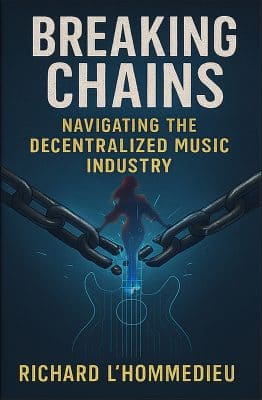The Hidden Cost of Centralized Streaming: How Platforms Like Spotify Hurt Indie Artists
Making a Scene Presents – The Hidden Cost of Centralized Streaming: How Platforms Like Spotify Hurt Indie Artists
Let’s face it—streaming music is easy. You tap your phone, open Spotify or Apple Music, and boom—millions of songs at your fingertips. For listeners, it feels like magic. You can listen to anything, anytime, and it barely costs a thing. But behind that convenience is a system that’s not so magical for the people making the music. In fact, for independent (or “indie”) artists, streaming can be more of a curse than a blessing.
This article is going to break down why. We’re going to look at how big platforms like Spotify actually hurt indie musicians, why the system is broken, and what new technology—like blockchain and Web3—is doing to fix it. Don’t worry, we’ll keep it simple, easy to understand, and maybe even a little bit fun.
The Illusion of Exposure
When Spotify first became popular, it sounded like a dream for musicians. Millions of people were listening. You didn’t need a record label to get your music out there. You could just upload it and become the next big thing. That dream turned into a nightmare for many indie artists.
You see, just being on Spotify doesn’t mean people will hear your music. There are over 100 million songs on the platform. That number grows every single day. It’s like throwing your song into a giant ocean and hoping someone swims by. Unless you’re already famous or lucky enough to land on one of Spotify’s curated playlists, most people will never even see your music.
Some musicians have even joked that their moms are the only ones streaming their songs. That’s because getting noticed on Spotify depends on an algorithm—a computer program that decides who hears what. And that algorithm doesn’t always play fair.
Algorithms Play Favorites
Let’s talk about that algorithm. You’ve probably seen Spotify’s playlists like “Discover Weekly” or “Release Radar.” These are curated by the platform’s algorithm based on what it thinks you’ll like. But here’s the catch: the algorithm is built to keep you listening longer, not necessarily to help indie musicians get discovered.
Spotify makes most of its money from people staying on the platform. So, the algorithm favors songs that are already popular. It pushes artists who already have a lot of plays. That means big stars like Taylor Swift or Drake keep getting more exposure, while unknown indie artists get pushed further down the line.
Even worse, Spotify recently rolled out something called “Discovery Mode,” where artists or labels can agree to lower royalties in exchange for more algorithmic exposure. That means indie musicians have to choose between being heard or being paid—and sometimes they still don’t get either.
The Truth About Royalties
Now let’s talk about money. You might think if a song gets played a lot on Spotify, the artist makes a decent living, right? Wrong. On average, Spotify pays artists between $0.003 and $0.005 per stream. That means you’d need about 250 streams to make just one dollar. If you want to make minimum wage in a month, you’d need over 200,000 streams.
But here’s the real kicker: most artists don’t even get that full amount. The money goes through multiple middlemen first. The record label takes a cut. The distributor takes a cut. If the artist is in a band, that money gets split again. In the end, the person who wrote and performed the song might get pennies—or nothing at all.
There are stories of indie musicians getting millions of streams and still being broke. One artist had a viral hit with over 1 million streams, but after all the splits and cuts, she only made around $300. That’s not even enough to pay rent.
Pay-to-Play Behind the Scenes
If that wasn’t bad enough, there’s another layer of unfairness happening behind the scenes. Some major labels and companies are paying to get their songs onto popular playlists. That’s right—those “curated” lists you trust to find new music? Some of them are bought and paid for.
It’s called “payola,” and while it’s technically illegal in radio, it’s still a grey area in streaming. Labels with big budgets can use influence and money to get their songs featured more. Indie artists, who can’t afford that kind of promotion, get pushed out of the spotlight. It’s a game of money and connections, not talent.
Spotify says it’s trying to level the playing field, but the truth is, the deck is still stacked against indie musicians.
The Shadow Ban Problem
Another hidden issue that indie artists face is what some are calling “shadow banning.” This means that your song might be on Spotify, but it won’t show up in searches, playlists, or recommendations. There’s no official notice—it just disappears from visibility. Why does this happen?
Some artists believe it’s because they don’t meet certain engagement metrics, or because they’re not releasing music often enough. Others think it’s due to how the algorithm ranks songs based on skip rates or play-throughs. Whatever the cause, the result is the same: artists get buried in the system without knowing why, and without any way to fix it.
Imagine pouring your heart into a song, uploading it with hope, and then finding out no one can even find it. That’s the reality many indie artists face today.
Fans Don’t Know the Full Story
Most listeners have no idea how bad it is for indie artists. They think, “Hey, I streamed your song! That must help, right?” But in reality, one stream is worth less than a penny. If fans really want to support their favorite musicians, they’d be better off buying a $1 download or even a piece of merch. But most people don’t know that because Spotify doesn’t exactly advertise how little it pays out.
The platform creates the illusion that it’s supporting artists, when really, it’s using their music to make money off subscriptions and ads. Spotify made over $13 billion in revenue last year, but most of that didn’t trickle down to the artists who made the music. That’s a broken system.
How Decentralized Platforms Change Everything
Here’s where the good news starts. A new kind of music platform is starting to rise—one that’s based on Web3 and blockchain technology. These platforms are called “decentralized,” which means they’re not controlled by a single company like Spotify. Instead, they’re built on open networks where artists have more control and more power.
Platforms like Audius, Sound.xyz, and even Napster’s new Web3 reboot are showing us what’s possible. On these platforms, artists can upload music directly and get paid instantly and fairly. There’s no middleman taking a huge cut. And the fans? They get to directly support the artists they love.
One of the biggest differences is how payments work. With blockchain, every time a song is played or sold as an NFT (a kind of digital collectible), the artist can receive money right away. There’s no waiting months for royalties. No label slicing off a big piece. It’s fast, fair, and transparent.
Some artists have made more money in one week on a Web3 platform than they made in years on Spotify.
Real Fans, Real Support
Another cool thing about decentralized music is how it brings artists and fans closer together. On platforms like Zora or Catalog, fans can actually own a piece of the music. They can buy a song as an NFT, which supports the artist and gives the fan something unique to hold on to.
This also opens the door for exclusive releases, early access, or even voting rights on what song an artist releases next. It’s like turning your fans into your team. Instead of trying to “go viral” and chase playlists, you build a real connection with your audience.
That’s something Spotify just can’t offer.
Building a New Music Economy
The current music industry feels a bit like a giant pyramid. At the top, a few big stars make all the money. In the middle, some signed artists are surviving. But at the bottom—where most indie musicians live—it’s a struggle just to make rent.
What Web3 and decentralized platforms are doing is flipping that pyramid upside down. They’re creating a world where more artists can earn a living. Where music isn’t just a product to be streamed endlessly, but something fans value, collect, and support.
This isn’t just good for musicians—it’s good for the world. More music, more voices, more stories. And not just from the people who can afford to “play the game.”
Is It Perfect Yet?
No system is perfect, and Web3 music is still growing. Not every fan understands how NFTs work yet. Not every artist is ready to jump into blockchain. And there are still questions around how these platforms will grow and scale.
But one thing is clear: the current system is broken, and indie artists are paying the price. We need a better way, and decentralized platforms are giving us a real shot at building one.
Final Thoughts: It’s Time to Take Back the Music
If you’re an indie artist reading this, it’s time to start thinking beyond Spotify. Yes, it’s okay to have your music there—it’s a tool like any other. But it shouldn’t be your only plan. You deserve better than a fraction of a penny for your hard work.
Start exploring platforms that actually value what you do. Learn about Web3. Talk to your fans about supporting you in new ways. Build your own path, because the old system wasn’t made for you—it was made to use you.
If you’re a music fan, it’s time to step up too. Streaming is fun and easy, but real support means going a little further. Buy the song. Share the link. Follow your favorite artist on a decentralized platform. Help them stay independent.
The music industry is changing, and you get to be part of that change. Let’s not let the same companies that broke the old system take over the new one. Let’s build something better. Something fair. Something real.
Because music deserves that. And so do the people who make it.
If you want to learn more about how you can use Web3 Technology to create a new music industry check out “Breaking Chains – Navigating the Decentralized Music Industry”
THIS IS THE BOOK THEY DON’T WANT YOU TO READ
Buy Us a Cup of Coffee!
Join the movement in supporting Making a Scene, the premier independent resource for both emerging musicians and the dedicated fans who champion them.
We showcase this vibrant community that celebrates the raw talent and creative spirit driving the music industry forward. From insightful articles and in-depth interviews to exclusive content and insider tips, Making a Scene empowers artists to thrive and fans to discover their next favorite sound.
Together, let’s amplify the voices of independent musicians and forge unforgettable connections through the power of music
Make a one-time donation
Make a monthly donation
Make a yearly donation
Buy us a cup of Coffee!
Or enter a custom amount
Your contribution is appreciated.
Your contribution is appreciated.
Your contribution is appreciated.
DonateDonate monthlyDonate yearlyYou can donate directly through Paypal!
Subscribe to Our Newsletter
Order the New Book From Making a Scene
Breaking Chains – Navigating the Decentralized Music Industry
Breaking Chains is a groundbreaking guide for independent musicians ready to take control of their careers in the rapidly evolving world of decentralized music. From blockchain-powered royalties to NFTs, DAOs, and smart contracts, this book breaks down complex Web3 concepts into practical strategies that help artists earn more, connect directly with fans, and retain creative freedom. With real-world examples, platform recommendations, and step-by-step guidance, it empowers musicians to bypass traditional gatekeepers and build sustainable careers on their own terms.
More than just a tech manual, Breaking Chains explores the bigger picture—how decentralization can rebuild the music industry’s middle class, strengthen local economies, and transform fans into stakeholders in an artist’s journey. Whether you’re an emerging musician, a veteran indie artist, or a curious fan of the next music revolution, this book is your roadmap to the future of fair, transparent, and community-driven music.
Get your Limited Edition Signed and Numbered (Only 50 copies Available) Free Shipping Included
Discover more from Making A Scene!
Subscribe to get the latest posts sent to your email.










